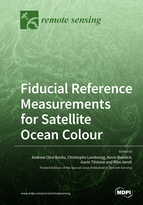Fiducial Reference Measurements for Satellite Ocean Colour
A special issue of Remote Sensing (ISSN 2072-4292). This special issue belongs to the section "Ocean Remote Sensing".
Deadline for manuscript submissions: closed (15 April 2020) | Viewed by 80197
Special Issue Editors
Interests: validation and vicarious calibration of satellite data; accuracy of satellite and in situ data (uncertainty and SI traceability); fiducial reference measurements; open ocean and coastal remote sensing of the Eastern Mediterranean; ocean color; sea surface temperature; albedo; BRDF; coastal zone; climate change
Special Issues, Collections and Topics in MDPI journals
Interests: signal processing; optics and lasers; data acquisition; calibration; aerosols; uncertainty analysis; optical metrology
Interests: optics; photosynthesis; primary production; phytoplankton biology; remote sensing
Interests: metrology, calibration and testing; SI traceability and uncertainty evaluation; characterization of measurement instruments; quality assurance; data validation; accuracy of in situ data; fiducial reference measurements; design of intercomparison measurements and analysis of comparison data; optical radiometry; thermometry, thermal effects and modelling; Earth observation; space technology
Special Issue Information
Dear Colleagues,
Fiducial Reference Measurements (FRM) are a suite of independent ground measurements that provide the maximum return on investment for a satellite mission by delivering to users the required confidence in data products, in the form of independent validation results and satellite measurement uncertainty estimation, over the entire end-to-end duration of a satellite mission. The FRM must have documented traceability to the SI units (in terms of an unbroken chain of calibrations and comparisons), be independent from the satellite retrieval process, have evaluated uncertainty budgets for all FRM instruments and measurement procedures applied, have defined and adhered-to protocols and community-wide management practices, and be openly available for independent scrutiny.
Within this context, the European Space Agency (ESA) has funded a series of projects targeting the validation of satellite data products (e.g., for altimetry, atmosphere, land, and ocean) and setting up the framework, standards, and protocols for future satellite validation efforts. The FRM4SOC project has been structured to provide support for evaluating and improving the state of the art in Ocean Colour Radiometry (OCR) through a series of comparisons under the auspices of the Committee on Earth Observation Satellites (CEOS) Working Group on Calibration & Validation and in support of the CEOS ocean colour virtual constellation. The methods of OCR give us valuable information on the management of the marine ecosystem, the role of the ocean ecosystem in climate change, aquaculture, fisheries, coastal zone water quality, and the mapping and monitoring of harmful algal blooms. This is how the FRM4SOC project makes a fundamental contribution to the European system for monitoring the Earth (Copernicus).
The objectives of the FRM4SOC, in particular, are to establish and maintain SI-traceable ground-based FRM for satellite OCR with the relevant protocols and uncertainty budgets for an ongoing international reference measurement system supporting the validation of satellite ocean colour. This is in support of ensuring the high quality and accuracy of Copernicus satellite mission data, in particular the Sentinel-2 MSI and Sentinel-3 OLCI ocean colour products.
The final workshop of the FRM4SOC project will take place at the National Physical Laboratory of the UK on October 4–5, 2018 (see https://frm4soc.org/index.php/activities/final_workshop/ ). This workshop has the title of "The Fiducial Reference Measurement Network for Satellite Ocean Colour" and the objective of forming an ocean colour community consensus-driven scientific roadmap for the future of satellite ocean colour validation.
In addition to the papers resultant from the FRM4SOC project and workshop, we invite the remote sensing community to submit papers on this presently “hot” topic in earth observation. Anything relevant to working towards fiducial reference measurements for satellite ocean colour validation or vicarious calibration will be accepted, for example on the following topics covered in the FRM4SOC workshop:
- Ocean Colour Radiometry (OCR) calibration source inter-comparisons;
- Laboratory-based OCR inter-comparisons;
- Field-based OCR inter-comparisons;
- SI traceability and end-to-end uncertainty budgets–from calibration to field measurements;
- Improvements in ocean colour radiometers, their calibration, and characterisation;
- Measurement requirements and protocols when operating FRM OCR for satellite validation
- Satellite ocean colour validation measurements and their uncertainties;
- FRM in the context of ocean colour system vicarious calibration;
Dr. Andrew Clive Banks
Dr. Christophe Lerebourg
Dr. Kevin Ruddick
Dr. Gavin Tilstone
Dr. Riho Vendt
Guest Editors
Manuscript Submission Information
Manuscripts should be submitted online at www.mdpi.com by registering and logging in to this website. Once you are registered, click here to go to the submission form. Manuscripts can be submitted until the deadline. All submissions that pass pre-check are peer-reviewed. Accepted papers will be published continuously in the journal (as soon as accepted) and will be listed together on the special issue website. Research articles, review articles as well as short communications are invited. For planned papers, a title and short abstract (about 100 words) can be sent to the Editorial Office for announcement on this website.
Submitted manuscripts should not have been published previously, nor be under consideration for publication elsewhere (except conference proceedings papers). All manuscripts are thoroughly refereed through a single-blind peer-review process. A guide for authors and other relevant information for submission of manuscripts is available on the Instructions for Authors page. Remote Sensing is an international peer-reviewed open access semimonthly journal published by MDPI.
Please visit the Instructions for Authors page before submitting a manuscript. The Article Processing Charge (APC) for publication in this open access journal is 2700 CHF (Swiss Francs). Submitted papers should be well formatted and use good English. Authors may use MDPI's English editing service prior to publication or during author revisions.
Keywords
- satellite ocean colour
- fiducial reference measurements (FRM)
- calibration and validation
- SI traceability and uncertainty
- Copernicus
- European Space Agency (ESA)
- CEOS









